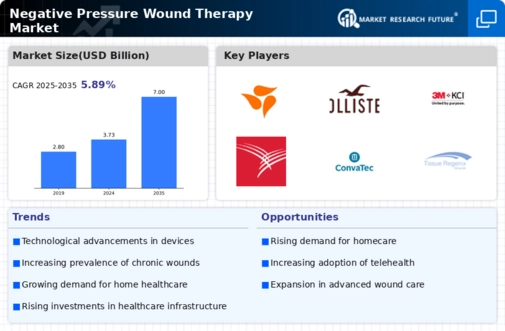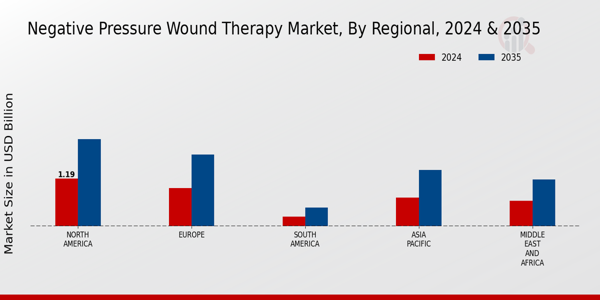Devices
Accessories
Therapeutic Solutions
Surgical Wounds
Chronic Wounds
Traumatic Wounds
Hospitals
Home Healthcare
Ambulatory Surgical Centers
Burns
Ulcers
Post-Operative Wounds
North America
Europe
South America
Asia Pacific
Middle East and Africa
North America Outlook (USD Billion, 2019-2035)
North America Negative Pressure Wound Therapy Market by Product Type
Devices
Accessories
Therapeutic Solutions
North America Negative Pressure Wound Therapy Market by Wound Type
Surgical Wounds
Chronic Wounds
Traumatic Wounds
North America Negative Pressure Wound Therapy Market by End Use Type
Hospitals
Home Healthcare
Ambulatory Surgical Centers
North America Negative Pressure Wound Therapy Market by Application Type
Burns
Ulcers
Post-Operative Wounds
North America Negative Pressure Wound Therapy Market by Regional Type
US
Canada
US Outlook (USD Billion, 2019-2035)
US Negative Pressure Wound Therapy Market by Product Type
Devices
Accessories
Therapeutic Solutions
US Negative Pressure Wound Therapy Market by Wound Type
Surgical Wounds
Chronic Wounds
Traumatic Wounds
US Negative Pressure Wound Therapy Market by End Use Type
Hospitals
Home Healthcare
Ambulatory Surgical Centers
US Negative Pressure Wound Therapy Market by Application Type
Burns
Ulcers
Post-Operative Wounds
CANADA Outlook (USD Billion, 2019-2035)
CANADA Negative Pressure Wound Therapy Market by Product Type
Devices
Accessories
Therapeutic Solutions
CANADA Negative Pressure Wound Therapy Market by Wound Type
Surgical Wounds
Chronic Wounds
Traumatic Wounds
CANADA Negative Pressure Wound Therapy Market by End Use Type
Hospitals
Home Healthcare
Ambulatory Surgical Centers
CANADA Negative Pressure Wound Therapy Market by Application Type
Burns
Ulcers
Post-Operative Wounds
Europe Outlook (USD Billion, 2019-2035)
Europe Negative Pressure Wound Therapy Market by Product Type
Devices
Accessories
Therapeutic Solutions
Europe Negative Pressure Wound Therapy Market by Wound Type
Surgical Wounds
Chronic Wounds
Traumatic Wounds
Europe Negative Pressure Wound Therapy Market by End Use Type
Hospitals
Home Healthcare
Ambulatory Surgical Centers
Europe Negative Pressure Wound Therapy Market by Application Type
Burns
Ulcers
Post-Operative Wounds
Europe Negative Pressure Wound Therapy Market by Regional Type
Germany
UK
France
Russia
Italy
Spain
Rest of Europe
GERMANY Outlook (USD Billion, 2019-2035)
GERMANY Negative Pressure Wound Therapy Market by Product Type
Devices
Accessories
Therapeutic Solutions
GERMANY Negative Pressure Wound Therapy Market by Wound Type
Surgical Wounds
Chronic Wounds
Traumatic Wounds
GERMANY Negative Pressure Wound Therapy Market by End Use Type
Hospitals
Home Healthcare
Ambulatory Surgical Centers
GERMANY Negative Pressure Wound Therapy Market by Application Type
Burns
Ulcers
Post-Operative Wounds
UK Outlook (USD Billion, 2019-2035)
UK Negative Pressure Wound Therapy Market by Product Type
Devices
Accessories
Therapeutic Solutions
UK Negative Pressure Wound Therapy Market by Wound Type
Surgical Wounds
Chronic Wounds
Traumatic Wounds
UK Negative Pressure Wound Therapy Market by End Use Type
Hospitals
Home Healthcare
Ambulatory Surgical Centers
UK Negative Pressure Wound Therapy Market by Application Type
Burns
Ulcers
Post-Operative Wounds
FRANCE Outlook (USD Billion, 2019-2035)
FRANCE Negative Pressure Wound Therapy Market by Product Type
Devices
Accessories
Therapeutic Solutions
FRANCE Negative Pressure Wound Therapy Market by Wound Type
Surgical Wounds
Chronic Wounds
Traumatic Wounds
FRANCE Negative Pressure Wound Therapy Market by End Use Type
Hospitals
Home Healthcare
Ambulatory Surgical Centers
FRANCE Negative Pressure Wound Therapy Market by Application Type
Burns
Ulcers
Post-Operative Wounds
RUSSIA Outlook (USD Billion, 2019-2035)
RUSSIA Negative Pressure Wound Therapy Market by Product Type
Devices
Accessories
Therapeutic Solutions
RUSSIA Negative Pressure Wound Therapy Market by Wound Type
Surgical Wounds
Chronic Wounds
Traumatic Wounds
RUSSIA Negative Pressure Wound Therapy Market by End Use Type
Hospitals
Home Healthcare
Ambulatory Surgical Centers
RUSSIA Negative Pressure Wound Therapy Market by Application Type
Burns
Ulcers
Post-Operative Wounds
ITALY Outlook (USD Billion, 2019-2035)
ITALY Negative Pressure Wound Therapy Market by Product Type
Devices
Accessories
Therapeutic Solutions
ITALY Negative Pressure Wound Therapy Market by Wound Type
Surgical Wounds
Chronic Wounds
Traumatic Wounds
ITALY Negative Pressure Wound Therapy Market by End Use Type
Hospitals
Home Healthcare
Ambulatory Surgical Centers
ITALY Negative Pressure Wound Therapy Market by Application Type
Burns
Ulcers
Post-Operative Wounds
SPAIN Outlook (USD Billion, 2019-2035)
SPAIN Negative Pressure Wound Therapy Market by Product Type
Devices
Accessories
Therapeutic Solutions
SPAIN Negative Pressure Wound Therapy Market by Wound Type
Surgical Wounds
Chronic Wounds
Traumatic Wounds
SPAIN Negative Pressure Wound Therapy Market by End Use Type
Hospitals
Home Healthcare
Ambulatory Surgical Centers
SPAIN Negative Pressure Wound Therapy Market by Application Type
Burns
Ulcers
Post-Operative Wounds
REST OF EUROPE Outlook (USD Billion, 2019-2035)
REST OF EUROPE Negative Pressure Wound Therapy Market by Product Type
Devices
Accessories
Therapeutic Solutions
REST OF EUROPE Negative Pressure Wound Therapy Market by Wound Type
Surgical Wounds
Chronic Wounds
Traumatic Wounds
REST OF EUROPE Negative Pressure Wound Therapy Market by End Use Type
Hospitals
Home Healthcare
Ambulatory Surgical Centers
REST OF EUROPE Negative Pressure Wound Therapy Market by Application Type
Burns
Ulcers
Post-Operative Wounds
APAC Outlook (USD Billion, 2019-2035)
APAC Negative Pressure Wound Therapy Market by Product Type
Devices
Accessories
Therapeutic Solutions
APAC Negative Pressure Wound Therapy Market by Wound Type
Surgical Wounds
Chronic Wounds
Traumatic Wounds
APAC Negative Pressure Wound Therapy Market by End Use Type
Hospitals
Home Healthcare
Ambulatory Surgical Centers
APAC Negative Pressure Wound Therapy Market by Application Type
Burns
Ulcers
Post-Operative Wounds
APAC Negative Pressure Wound Therapy Market by Regional Type
China
India
Japan
South Korea
Malaysia
Thailand
Indonesia
Rest of APAC
CHINA Outlook (USD Billion, 2019-2035)
CHINA Negative Pressure Wound Therapy Market by Product Type
Devices
Accessories
Therapeutic Solutions
CHINA Negative Pressure Wound Therapy Market by Wound Type
Surgical Wounds
Chronic Wounds
Traumatic Wounds
CHINA Negative Pressure Wound Therapy Market by End Use Type
Hospitals
Home Healthcare
Ambulatory Surgical Centers
CHINA Negative Pressure Wound Therapy Market by Application Type
Burns
Ulcers
Post-Operative Wounds
INDIA Outlook (USD Billion, 2019-2035)
INDIA Negative Pressure Wound Therapy Market by Product Type
Devices
Accessories
Therapeutic Solutions
INDIA Negative Pressure Wound Therapy Market by Wound Type
Surgical Wounds
Chronic Wounds
Traumatic Wounds
INDIA Negative Pressure Wound Therapy Market by End Use Type
Hospitals
Home Healthcare
Ambulatory Surgical Centers
INDIA Negative Pressure Wound Therapy Market by Application Type
Burns
Ulcers
Post-Operative Wounds
JAPAN Outlook (USD Billion, 2019-2035)
JAPAN Negative Pressure Wound Therapy Market by Product Type
Devices
Accessories
Therapeutic Solutions
JAPAN Negative Pressure Wound Therapy Market by Wound Type
Surgical Wounds
Chronic Wounds
Traumatic Wounds
JAPAN Negative Pressure Wound Therapy Market by End Use Type
Hospitals
Home Healthcare
Ambulatory Surgical Centers
JAPAN Negative Pressure Wound Therapy Market by Application Type
Burns
Ulcers
Post-Operative Wounds
SOUTH KOREA Outlook (USD Billion, 2019-2035)
SOUTH KOREA Negative Pressure Wound Therapy Market by Product Type
Devices
Accessories
Therapeutic Solutions
SOUTH KOREA Negative Pressure Wound Therapy Market by Wound Type
Surgical Wounds
Chronic Wounds
Traumatic Wounds
SOUTH KOREA Negative Pressure Wound Therapy Market by End Use Type
Hospitals
Home Healthcare
Ambulatory Surgical Centers
SOUTH KOREA Negative Pressure Wound Therapy Market by Application Type
Burns
Ulcers
Post-Operative Wounds
MALAYSIA Outlook (USD Billion, 2019-2035)
MALAYSIA Negative Pressure Wound Therapy Market by Product Type
Devices
Accessories
Therapeutic Solutions
MALAYSIA Negative Pressure Wound Therapy Market by Wound Type
Surgical Wounds
Chronic Wounds
Traumatic Wounds
MALAYSIA Negative Pressure Wound Therapy Market by End Use Type
Hospitals
Home Healthcare
Ambulatory Surgical Centers
MALAYSIA Negative Pressure Wound Therapy Market by Application Type
Burns
Ulcers
Post-Operative Wounds
THAILAND Outlook (USD Billion, 2019-2035)
THAILAND Negative Pressure Wound Therapy Market by Product Type
Devices
Accessories
Therapeutic Solutions
THAILAND Negative Pressure Wound Therapy Market by Wound Type
Surgical Wounds
Chronic Wounds
Traumatic Wounds
THAILAND Negative Pressure Wound Therapy Market by End Use Type
Hospitals
Home Healthcare
Ambulatory Surgical Centers
THAILAND Negative Pressure Wound Therapy Market by Application Type
Burns
Ulcers
Post-Operative Wounds
INDONESIA Outlook (USD Billion, 2019-2035)
INDONESIA Negative Pressure Wound Therapy Market by Product Type
Devices
Accessories
Therapeutic Solutions
INDONESIA Negative Pressure Wound Therapy Market by Wound Type
Surgical Wounds
Chronic Wounds
Traumatic Wounds
INDONESIA Negative Pressure Wound Therapy Market by End Use Type
Hospitals
Home Healthcare
Ambulatory Surgical Centers
INDONESIA Negative Pressure Wound Therapy Market by Application Type
Burns
Ulcers
Post-Operative Wounds
REST OF APAC Outlook (USD Billion, 2019-2035)
REST OF APAC Negative Pressure Wound Therapy Market by Product Type
Devices
Accessories
Therapeutic Solutions
REST OF APAC Negative Pressure Wound Therapy Market by Wound Type
Surgical Wounds
Chronic Wounds
Traumatic Wounds
REST OF APAC Negative Pressure Wound Therapy Market by End Use Type
Hospitals
Home Healthcare
Ambulatory Surgical Centers
REST OF APAC Negative Pressure Wound Therapy Market by Application Type
Burns
Ulcers
Post-Operative Wounds
South America Outlook (USD Billion, 2019-2035)
South America Negative Pressure Wound Therapy Market by Product Type
Devices
Accessories
Therapeutic Solutions
South America Negative Pressure Wound Therapy Market by Wound Type
Surgical Wounds
Chronic Wounds
Traumatic Wounds
South America Negative Pressure Wound Therapy Market by End Use Type
Hospitals
Home Healthcare
Ambulatory Surgical Centers
South America Negative Pressure Wound Therapy Market by Application Type
Burns
Ulcers
Post-Operative Wounds
South America Negative Pressure Wound Therapy Market by Regional Type
Brazil
Mexico
Argentina
Rest of South America
BRAZIL Outlook (USD Billion, 2019-2035)
BRAZIL Negative Pressure Wound Therapy Market by Product Type
Devices
Accessories
Therapeutic Solutions
BRAZIL Negative Pressure Wound Therapy Market by Wound Type
Surgical Wounds
Chronic Wounds
Traumatic Wounds
BRAZIL Negative Pressure Wound Therapy Market by End Use Type
Hospitals
Home Healthcare
Ambulatory Surgical Centers
BRAZIL Negative Pressure Wound Therapy Market by Application Type
Burns
Ulcers
Post-Operative Wounds
MEXICO Outlook (USD Billion, 2019-2035)
MEXICO Negative Pressure Wound Therapy Market by Product Type
Devices
Accessories
Therapeutic Solutions
MEXICO Negative Pressure Wound Therapy Market by Wound Type
Surgical Wounds
Chronic Wounds
Traumatic Wounds
MEXICO Negative Pressure Wound Therapy Market by End Use Type
Hospitals
Home Healthcare
Ambulatory Surgical Centers
MEXICO Negative Pressure Wound Therapy Market by Application Type
Burns
Ulcers
Post-Operative Wounds
ARGENTINA Outlook (USD Billion, 2019-2035)
ARGENTINA Negative Pressure Wound Therapy Market by Product Type
Devices
Accessories
Therapeutic Solutions
ARGENTINA Negative Pressure Wound Therapy Market by Wound Type
Surgical Wounds
Chronic Wounds
Traumatic Wounds
ARGENTINA Negative Pressure Wound Therapy Market by End Use Type
Hospitals
Home Healthcare
Ambulatory Surgical Centers
ARGENTINA Negative Pressure Wound Therapy Market by Application Type
Burns
Ulcers
Post-Operative Wounds
REST OF SOUTH AMERICA Outlook (USD Billion, 2019-2035)
REST OF SOUTH AMERICA Negative Pressure Wound Therapy Market by Product Type
Devices
Accessories
Therapeutic Solutions
REST OF SOUTH AMERICA Negative Pressure Wound Therapy Market by Wound Type
Surgical Wounds
Chronic Wounds
Traumatic Wounds
REST OF SOUTH AMERICA Negative Pressure Wound Therapy Market by End Use Type
Hospitals
Home Healthcare
Ambulatory Surgical Centers
REST OF SOUTH AMERICA Negative Pressure Wound Therapy Market by Application Type
Burns
Ulcers
Post-Operative Wounds
MEA Outlook (USD Billion, 2019-2035)
MEA Negative Pressure Wound Therapy Market by Product Type
Devices
Accessories
Therapeutic Solutions
MEA Negative Pressure Wound Therapy Market by Wound Type
Surgical Wounds
Chronic Wounds
Traumatic Wounds
MEA Negative Pressure Wound Therapy Market by End Use Type
Hospitals
Home Healthcare
Ambulatory Surgical Centers
MEA Negative Pressure Wound Therapy Market by Application Type
Burns
Ulcers
Post-Operative Wounds
MEA Negative Pressure Wound Therapy Market by Regional Type
GCC Countries
South Africa
Rest of MEA
GCC COUNTRIES Outlook (USD Billion, 2019-2035)
GCC COUNTRIES Negative Pressure Wound Therapy Market by Product Type
Devices
Accessories
Therapeutic Solutions
GCC COUNTRIES Negative Pressure Wound Therapy Market by Wound Type
Surgical Wounds
Chronic Wounds
Traumatic Wounds
GCC COUNTRIES Negative Pressure Wound Therapy Market by End Use Type
Hospitals
Home Healthcare
Ambulatory Surgical Centers
GCC COUNTRIES Negative Pressure Wound Therapy Market by Application Type
Burns
Ulcers
Post-Operative Wounds
SOUTH AFRICA Outlook (USD Billion, 2019-2035)
SOUTH AFRICA Negative Pressure Wound Therapy Market by Product Type
Devices
Accessories
Therapeutic Solutions
SOUTH AFRICA Negative Pressure Wound Therapy Market by Wound Type
Surgical Wounds
Chronic Wounds
Traumatic Wounds
SOUTH AFRICA Negative Pressure Wound Therapy Market by End Use Type
Hospitals
Home Healthcare
Ambulatory Surgical Centers
SOUTH AFRICA Negative Pressure Wound Therapy Market by Application Type
Burns
Ulcers
Post-Operative Wounds
REST OF MEA Outlook (USD Billion, 2019-2035)
REST OF MEA Negative Pressure Wound Therapy Market by Product Type
Devices
Accessories
Therapeutic Solutions
REST OF MEA Negative Pressure Wound Therapy Market by Wound Type
Surgical Wounds
Chronic Wounds
Traumatic Wounds
REST OF MEA Negative Pressure Wound Therapy Market by End Use Type
Hospitals
Home Healthcare
Ambulatory Surgical Centers
REST OF MEA Negative Pressure Wound Therapy Market by Application Type
Burns
Ulcers
Post-Operative Wounds










Leave a Comment